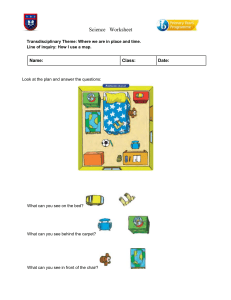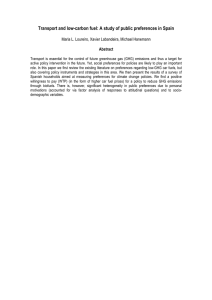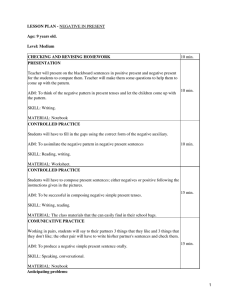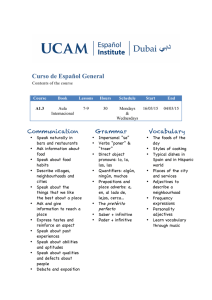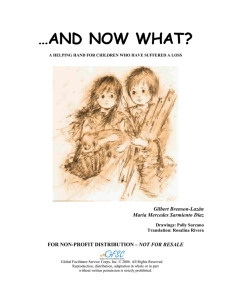universidad abierta para adultos uapa vicerrectoria academica
Anuncio
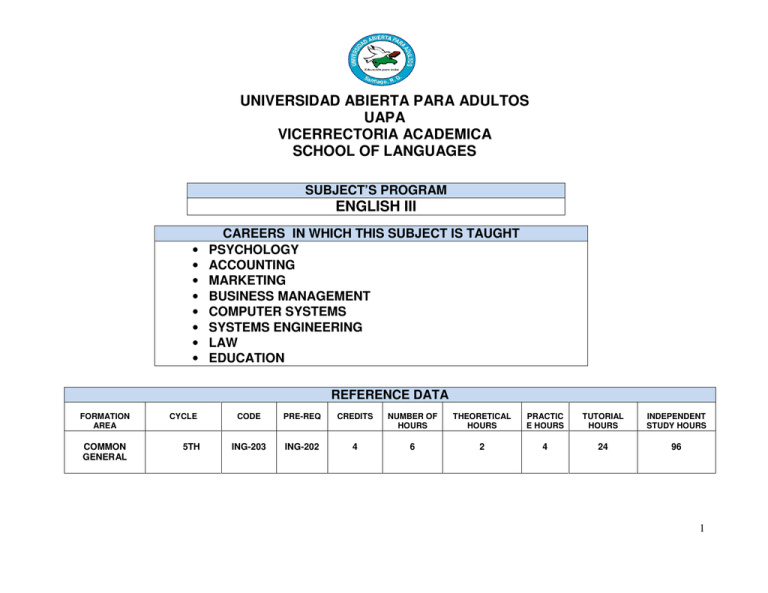
UNIVERSIDAD ABIERTA PARA ADULTOS UAPA VICERRECTORIA ACADEMICA SCHOOL OF LANGUAGES SUBJECT’S PROGRAM ENGLISH III • • • • • • • • CAREERS IN WHICH THIS SUBJECT IS TAUGHT PSYCHOLOGY ACCOUNTING MARKETING BUSINESS MANAGEMENT COMPUTER SYSTEMS SYSTEMS ENGINEERING LAW EDUCATION REFERENCE DATA FORMATION AREA COMMON GENERAL CYCLE 5TH CODE PRE-REQ CREDITS NUMBER OF HOURS THEORETICAL HOURS PRACTIC E HOURS TUTORIAL HOURS INDEPENDENT STUDY HOURS ING-203 ING-202 4 6 2 4 24 96 1 THE SUBJECT’S PRESENTATION English III represents another step ahead in the language subjects included in all the University´s study programs. This level continues with the purpose to develop communicative competences in a foreign language like English, as it has been set and planned by the Institution. Level III provides more advanced tools to participants, so that they will be able to participate more actively and fluently in dialogs that require a higher level of comprehension and production, be it written or oral. In this subject, participants have the chance to speak and write about topics like: shopping habits, countries, nationalities, capitals, official languages of countries around the world, food preferences, things they like and don´t like, places they live in, and so forth. PRIOR KNOWLEDGE • All the competences developed in English levels I and II. EDUCATIONAL PURPOSE • Provide participants with the right linguistic tools to make them competent in reading, writing, listening, and speaking in the English language. PROFESSIONAL PROFILE’S COMPETENCES General competence • Capacity to communicate, orally and in the written form, in the mother tongue and in a foreign language. 2 THE SUBJECT’S SPECIFIC COMPETENCES • • • • • • • • • • • • • • • • • • • • • • • • • • • Asks about and identifies locations to find and explain addresses. Describes the house in which she/he lives, also the houses of other people she/he knows. Identifies the different rooms of a house or an apartment. Talks and writes about various types of transportation, to express his/her transportation preferences. Greets people in English in any situation of communication. Uses numbers to count and refer to quantities. Follows and gives instructions depending on the situation. Asks for and gives personal information at a more advanced level. Makes physical and personality descriptions of people she/he knows. Talks and writes about family relationships. Expresses preferences about sports and music. Plans a study schedule by using time expressions properly. Identifies places to make purchases. Describes clothes people are wearing at the moment of speaking. Describes sections and items in a store. Describes articles of clothing by using colors. Talks and writes about meals and foods. Interprets food advertisements. Places orders in a restaurant. Compares prices of items. Expresses food preferences. Expresses needs in different communication settings. Identifies types of housing. Describes parts of a home. Interprets classified ads. Uses the phone to make appointments. Identifies furniture in a house. 3 CONTENTS AND ACTIVITIES PER UNIT: FIRST WEEK UNIT UNIT 0: WELCOME TO OUR CLASS Communication: 0.1.Greet and meet classmates in the new class. 0.2.Follow and give instructions. 0.3.Exchange personal information. Grammar: 0.4.The verb Be in present. Vocabulary: 0.5.Expressions of greeting. 0.6.Numbers. 0.7.Expressions of time. 0.8.Personal information. TUTORIAL INTERACTION ACTIVITIES 3 TIH INDEPENDENT STUDY ACTIVITIES 12 ISH 1. The facilitator presents and explains the program and the competences planned for the level. 15 Min. 2 Hours 2. Participants will talk to each other to get to know themselves. 10 Min. 1. Pre-unit, lesson 1, worksheet 1, in which participants will practice simple dialogs, will write sentences about the conversations read, and will read a paragraph about someone´s introduction. 3. The facilitator will make a feedback about topics (names, phone numbers, jobs, nationalities, food preferences…) discussed in previous levels, as a way to evaluate prior knowledge. 5 Min. 2. Complete the written practices found in the Grammar Challenge workbook, from page P2 to P7. 8 Hours. 4. Listening: Participants will listen to people talk about themselves, give personal information, like phone numbers addresses, age, and so forth… 10 Min. 5. Textbook activities, which include all the exercises to be done in the classroom. 70 Min. 6. Reading through the platform: There is a reading participants will study to answer some questions and complete a chart about the reading. 7. Social forum: participants will express the expectations concerning the subjects. 3. Homework: participants are to write a large personal introduction, in which they even can talk about some of their likes and dislikes in life. EXPECTED RESULTS 1. Participants use expressions of greeting to make contact with their classmates and other people. 2. They understand and execute classroom instructions, and also show competence to give instructions properly. 2 Hours. 3. They correctly use expressions of time to refer to activities and their different schedules. 4. They can interact to exchange personal information with classmates and other people outside class. 45 Min. 15 Min. 4 CONTENTS AND ACTIVITIES PER UNIT: SECOND AND THIRD WEEKS UNIT UNIT I TALKING WITH OTHERS Communication: 1.1.Talk about family members and share information about family relationships. 1.2.Describe physical appearances and personalities of other people. 1.3.Identify countries, nationalities, and official languages. 1.4.Share information about things one likes and doesn´t like (express preferences). 1.5.Talk and write about class schedules. Grammar: 1.6.Simple present of ¨Be¨ (continuation). 1.7.Third person possessive adjectives. 1.8.Present of¨Have¨. 1.9.Adjective order. 1.10.Simple present of ¨Like¨. Vocabulary: 1.11.Names of countries, nationalities, and languages. 1.12.Colors, hairstyles, height, weight, age, adjectives to describe personalities. 1.13.Family vocabulary. 1.14.Words related to entertainment. 1.15.Clock times. TUTORIAL INTERACTION ACTIVITIES 6 TIH INDEPENDENT STUDY ACTIVITIES 28 ISH 1. Speaking: participants will look at illustrations about family relationships and about which they are to make descriptions. 2. The world map: by looking at a world map, participants will identify countries and nationalities, as well as languages of the world. 3. Class work: participants will describe themselves physically and in terms of their personality. 4. Group work: by getting together, participants share information about their families. 5. Pair work: they will talk about things they like and don´t like (preferences). 10 Min. 1. Reading: participants will read a text about someone´s family. Later, they are answering questions on the reading. 2 Hours. 2. Writing: they will write a composition about their families. 2 Hours. 3. Practice: lesson one, worksheets 1 and 2: participants will complete application forms and a practice of some people´s physical descriptions. 2 Hours. 4. Practice: lesson 2 worksheets: family vocabulary and family trees, from Activity Bank CD. 2 Hours. 5. Practice: lesson 4 worksheet 1A: express likes and dislikes; simple present of ¨like¨, simple present of other verbs. 2 Hours. 6. Grammar challenge exercises, from page 2 to 15. 18 Hours. 6. Group work: participants will work in groups to talk about times they do certain activities. 10 Min. 10 Min. 10 Min. 10 Min. 10 Min. 7. Textbook: practices of the unit. 140 Min. 8. Listening: listen to some people say their study schedules. 1 Hour. 9. Academic forum: What kind of person are you? What things are to your liking? Hour. EXPECTED RESULTS 1. Participants are able to talk about their families with friends and other people. 2. They have the competence to describe people physically and make simple comments about people´s personality. 3. They can talk about different countries of the world, in terms of their locations and languages, also identify nationalities. 4. They are able to share information about what their preferences are, in terms of entertainment. 5. They can use the simple present tense of some verbs to refer to common activities and routines they carry out. 6. Participants can talk and write about their study schedules. 1 7. They know very well how to use and collocate adjectives in the English language. 5 CONTENTS AND ACTIVITIES PER UNIT: FOURTH AND FITH WEEKS UNIT UNIT II LET´S GO SHOPPING Communication: 2.1.Talk about shopping habits and things one likes to purchase. 2.2.Describe clothes people are wearing. 2.3.Describe and speak about sections in a store. Grammar: 2.4.Simple present tense: shop, buy, purchase, want, like. 2.5.The use of how much and how many to ask for quantities and prices. 2.6.Singular and plural, possessive adjectives. Vocabulary: 2.7.Types of stores and products. 2.8.Money, amounts, bills, coins. 2.9.Clothings and colors. 2.10.Adjectives of size, shape, age,, pattern. TUTORIAL INTERACTION ACTIVITIES 6 TIH 1. Group work: participants will work in groups to speak about their shopping habits and what things they like to buy. 20 Min. 2. Class activity: by looking at some pictures, participants are going to describe the clothes the people on the pictures are wearing. 20 Min. 3. Clothing vocabulary: the whole class will make a list of all the names of clothes people wear. 10 Min. 4. Listening: participants will listen to some people´s dressing preferences, afterwards, they will answer questions based on what they hear. 20 Min. 5. Textbook: the whole class will work on the practices of unit II in the book. INDEPENDENT STUDY ACTIVITIES 28 ISH 1. Check and ledgers: from Activity Bank: they will complete some checks and ledgers from the information given by the receipts. This is worksheet 1. 2 Hours. 2. Lesson 3, worksheet 1A, clothing vocabulary: they will complete a chart after reading some conversations about shopping. 2 Hours. 3. Reading: lesson 4, worksheet 1A, read a paragraph on clothes and provide the missing information in chart. 2 Hours. 140 Min. 4. Lesson 5, worksheet 1A, complete exercises about the use of adjectives for clothes. 2 Hours. 6. Shopping: Pair work: participants are going to practice shopping dialogs by having different information on charts distributed by the facilitator. Lesson I, worksheet one A, from Activity Bank. 10 Min. 5. Writing: participants are to 2 write about what they like to wear Hours. in different seasons of the year. 7. Academic forum: participants are to write about the dressing preferences for different occasions. 30 Min. 8. Doubt forum: make any question you have about the Final Production. 30 Min. 7. Platform homework: participants will describe the various sections of store they know in their community. 2 Hours. 6. The workbook exercises, from page 16 to 29. 16 Hours. EXPECTED RESULTS 1. Participants have the capacity to participate and interact in conversations related to things they like shopping. 2. They use names and colors of clothes properly to describe what people are wearing at the time speaking. 3. They are able to describe the different sections in a store, by using a more advanced vocabulary than in level one. 4. They have the knowledge to conjugate the verbs shop, like, want, and purchase correctly in the present tense, that includes affirmative, negative, and interrogative forms. 5. Participants are able to use expressions of quantities to talk about prices of items in a store. 6. They have the capacity to use clothing vocabulary to refer to adjectives of size, shapes, age, pattern, and possessive ones. 6 CONTENTS AND ACTIVITIES PER UNIT: SIXTH WEEK UNIT UNIT III: FOOD. Communication: 3.1.Talk about food preferences. 3.2. Read and interpret food ads. 3.3.Compare prices of food items. 3.4.Share information eating habits. 3.5.Place an order in a restaurant. Grammar: 3.7. Simple present tense (continued). 3.8.Comparative adjectives. 3.9.Questions and yes-no answers. Vocabulary: 3.10.Food vocabulary (more advanced words). 3.11.Quantities and containers. 3.12.Words to make comparisons. 3.13.Menu sections. TUTORIAL INTERACTION ACTIVITIES 6 TIH 1. Group work: participants will get together to share information about their food preferences and eating habits. 10 Min. 2. Class work: the facilitator and participants will construct a concept mapping with food vocabularies. 10 Min. 3. Dictation: the facilitator will dictate a reading about a person´s eating habits and preferences; participants are to write what they hear. 10 Min. 4. Drama: participants are going to dramatize the situation of eating in a restaurant. 10 Min. 6. By looking at pictures, participants are going to identify the food item. 20 Min. 7. Textbook: participants and the facilitator will do all the exercises in the book, unit 3. 150 Min. 9. Listening: Unit 3 extension worksheet 1A: Participants will hear some people talk about how to prepare some recipes, and then an exercise will be completed. 10 Min. 8. Academic Forum: Do you think food influences our personality? Why? 1 Hour INDEPENDENT STUDY ACTIVITIES 1. Unit 3, lesson 1 worksheet 1A: participants are going to complete some written practices about favorite American food and their own favorite food. 2. Unit 3, lesson 2 worksheet 1A: participants are to read and interpret ads about food; they will use the expressions: How much is/How much are .They will also practice some dialogs of the same kind in the classroom. 28 ISH EXPECTED RESULTS 2 Hours. 1. They are able to express their preferences about food. 2. Participants have the capacity to read and understand simple food ads in the target language. 2 Hours. 3. They can participate and interact well in conversations concerning eating habits. 4. They can place an order in a restaurant. 3. Unit 3, lesson 5 worksheet 1B: they practice how to read a menu and will complete a chart based on the information given in the handout. 2 Hours. 4. Practices from the workbook: from page 30 to 43. 18 Hours. 5. Platform homework: Writing: participants are to write a composition about their likes and dislikes concerning food and meals of the day. 2 Hours. 5. They know how to make simple comparisons of prices referred to food. 6. They use expressions of quantities to ask for prices and other parameters of measures. 7. They have a large vocabulary of food items. 7 CONTENTS AND ACTIVITIES PER UNIT: SEVENTH WEEK UNIT UNIT IV: HOUSING Communication: 4.1.Talk about types of housing. 4.2.Interpret and discuss classified ads. 4.3.Make appointments via the phone. 4.4.Describe furniture in a house. 4.5.Describe the parts of a house. Grammar: 4.6.The use of the indefinite article: A/An. 4.7.The simple present tense of: live/have/. 4.8.Present progressive tense. 4.9.Prepositions of location. Vocabulary: 4.10.Housing vocabulary 4.11.Parts of a home. 4.12.Classified ads, utilities. 4.13.Appointments. 4.14.Furniture. TUTORIAL INTERACTION ACTIVITIES 1. Participants will be asked by the facilitator what city they live in, and will talk about their community. 2. By looking at pictures, participants will identify and name the parts of house or an apartment. 3. Dictation: the facilitator reads a text which describes the housing of somebody while participants will write what they hear. 4. Speaking: participants will talk to class about their housing preferences: a house or an apartment. 5. Drama: participants will play roles to dramatize situations in which they make business appointments on the phone. 6. By looking at pictures, participants are going to identify and name different furniture. 7. Textbook exercises concerning the unit: To be done in the classroom by the facilitator and participants. 8. Listening: they are to listen to some people talk about the type of housing wanted to complete a practice from the Activity Bank (lesson 1, worksheet 1, also lesson 2, worksheet 2) 9. Interaction: participants are to interact through asking questions to classmates about their homes (lesson 2, worksheet 2, Activity Bank). 10. Academic forum: What country would you like to live and why? 6 TIH 10 Min. 10 Min. 10 Min. 10 Min. 10 Min. 10 Min. 140 Min. 10 Min. 10 Min. INDEPENDENT STUDY ACTIVITIES 1. Extension unit: worksheet 1C: participants are going to read budgets and prepare one on their own. 2. Housing: lesson 1, worksheet 1. Read some paragraphs about housing preferences to answer questions afterwards. 3. Reading: participants will read some dialogs about rooms in a house (lesson 2, worksheet 2, Activity Bank). 4. Classifieds: participants are reading and interpreting classified ads to later complete some exercises (lesson 3, worksheet 3C, Activity Bank). 5. Practice for the present continuous tense: Lesson 4, worksheet 4C, Activity Bank. 6. Prepositions of location: participants are going to look at a floor plan to locate different places by using prepositions of location (lesson 5, worksheet 5C, Activity Bank). 7. The Home Design Project: participants can work in groups to make the design of a house; they have to play different roles: architect, leader, engineer, and so forth (Project from Activity Bank). 8. Exercises in the Grammar Challenge book, from page 44 to 57. 9. Platform task: writing: participants are going to write about their dream house or apartment. 10. Platform task: geography quiz. Participants will answer geography questions on a test. 28 ISH EXPECTED RESULTS 2 Hours. 1. They are able to make simple descriptions of houses and apartments. 2 Hours. 2. They can refer to the type of housing they prefer by using the proper vocabulary. 2 Hours. 3. They have the capacity to identify and name the different parts of a house. 4. They read and interpret classified ads concerning housing sells. 2 Hours. 5. They name different furniture of a house or an apartment. 4 Hours. 6. They are able to locate places and objects in a house by using the right preposition of location. 2 Hours. 14 Hours. 1 Hour 8 CONTENTS AND ACTIVITIES PER UNIT: EIGHTH WEEK TUTORIAL INTERACTION ACTIVITIES 3 TIH 1. Feedback about questions originated from activities done as independent studies. 2. Handing in of final Project. 15 Min. INDEPENDENT STUDY ACTIVITIES 1-. Assessment of participations in forums, homework, and other platform activities. EXPECTED RESULTS 1-. Handing in Projects on time. 45 Min. 2- Learning Self-evaluation. 3. Final Department Test. 50 Min. 3. Coevaluation. 4- Final Project’s form and content corrections. 9 LEARNING PROCESS EVALUATION CRITERIA Oral Production and Interaction Activities ACTIVITIES -Virtual and oral presentations. -Interaction activities (synchronic and asynchronic). -Asynchronic interaction activities. Written Production Activities. -Essays -Research paper -Questionnaires and exercises -Reflexive diaries and concept maps. -Case studies. -Problem solutions. -Projects. -Portfolio. Professional Practical Activities -Field Projects. -Practices in situ. -Lab. Practices. -Simulation Practices. INDICATORS Information Organization. Great knowledge of the topic: rigor, clarity, precision, and presentation of ideas with the proper profoundness. Pertinence of argumentation in participations. Coherence, clarity, and originality of the ideas expressed. Linguistic correction: right word-power, sentence structure, pronunciation. Right knowledge of writing and orthography. Good use of technological resources. Capacity to look for and select information. Creativity in the presentations made. Capacity for teamwork. Right and pertinent participations. Respect towards the agreed upon communication rules. Coherence, clarity, and originality of the ideas expressed. Celerity and punctuality in handing in assignments. Clarity, quality, objectivity, and pertinence of participation. Coherence and originality of the ideas expressed. Good use of technological resources. Celerity and punctuality in handing in assignments. Organization of the information presented. Facts and data. Principles and concepts. Skills to investigate. Procedural contents. Thinking abilities. Application. Professional skills. Facts and data. Principles and concepts. Procedural contents. Thinking abilities. Activities and values (responsibility, decision making). Facts and data. Principles and concepts. Procedural contents. Thinking abilities. Activities and values (responsibility, decision making). Application. Professional skills. Facts and data. Principles and concepts. Procedural contents. Thinking abilities. Activities and values (responsibility, decision making). Time management, collaboration). Reflection. Creativity. Logical order in the Organization of the information presented. The advancement of the learning process according to the topics treated. Capacity to question and criticism of the ideas expressed through written and oral forms. Projects addressed to field work that will link theory to practice. Practical activities done by the participants of a subject in institutions and enterprises whose activities are related to their field of study. Practical activities done by the participants of a subject in inside and outside specialized laboratories. Activities done by participants, who will simulate reality on stage, be it physical or virtual. (%) 10% 15% 15% 10 -Short Written Test. answers and completions. -Multiple Alternatives. – Matching, Association, and Ordering. -Multiple Choice –Essay questions. -Quality -Ethics -Cooperation. Attitudes and values -Responsibility. -Solidarity. -Pluralism. -Innovation. -Equity. -Knowledge -Comprehension -Application 50% -Analysis -Synthesis -Written consideration -Critical reasoning Commitment to do their homework according to the efficiency standards set beforehand. Shows moral commitment in his-her actions as a student. - Promotes cooperative and collaborative work as a way to develop collective potentialities. -Shows a good attitude towards team work. -Commitment to respond to his-her duties as participant and citizen – Punctuality. – Faces consequences of his-her actions. - Participates actively in group decision making. - Shares with his-her classmates. – He-she is generous. – Promotes actions to motivate and lead common aims. - He- she feels identified with the preservation of biodiversity and his- her sociocultural environment. - Respect towards the institutional patrimony. – He- she listens carefully to others. -Respect towards ethnic, ideological, religious, and gender diversity. – He- she values the expression and discussion of ideas, and opinions of others. –Respect the order of participation. –He- she is tolerant and moderate in his- her opinions. - Shows creativity and talent in his- her homework. –Shows initiative and interest in the academic work. -Shows openness and receptivity towards science advancements. -Disposition to make good and balanced decisions. -Impartiality in his- her opinions. 10% 11 First week of class Weekly assignments Doubts forum Final Production (Written and oral). Written test INFORMATION TO REMEMBER The facilitator will begin the subject by socializing the program, the general and specific competences to be reached by the participant, besides, the facilitator will explain the evaluation parameters and how to develop every process around the 8 weeks. This first week of class, the facilitator and the participants are going to form the different groups for weekly presentations. Explanation and distribution of the Final Project (Oral and written). To be handed in next week after being assigned or uploaded to the virtual campus. It is important to study the content of every unit to develop the competences of the subject, it is also important to hand in assignments the due dates and follow the rules established. Doubts about the Final Project are to be responded through a forum to be uploaded the third week of class. The facilitator is going to explain which this activity of production will be. The production will be written and presented orally. It´ll be assigned the first week of class and presented orally around the 6th and 7th weeks. The written part is to be handed in the last week. To be applied the last week of class. It is based on the contents of the program and the due results. 12 BIBLIOGRAPHY BASIC 1) JENKINS, ROB AND STACY JOHNSON: Stand out I. SECOND EDITION. BOSTON, HEINLE, CENGAGE LEARNING, 2009. 2) JENKINS, ROB AND STACY JOHNSON: Stand out I: Grammar challenge. SECOND EDITION. BOSTON, HEINLE, CENGAGE LEARNING, 2009. THE SUBJECT´S FACILITATOR´S PROFILE: The facilitator for this subject must be licensed on languages and have a professional preparation and experience on language teaching, as well as the following qualities for teaching basic English: patience and tolerance for working with beginners; open-minded and dynamic. Done by: José Parra: Language School Director REVISED BY: Luz Rosa Estrella, Director of the Curriculum Reform Office. Ph.D. in Education. Pedro Emilio Ventura, Coordinator of the Curriculum Reform Office. Master in Marketing. Elizabeth Filpo, Tourism School Professor. This program was finished and approved by the Curriculum Reform Office, May 2011. 13
